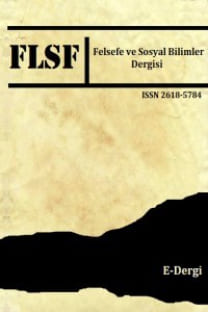LUDWIG WITTGENSTEIN’IN “SİNEK ŞİŞESİNDEKİ SİNEK” METAFORUNA DAİR
Ludwig Wittgenstein, dil felsefesinin akış yönünü iki kez değiştirmeyi başaran önemli bir filozof olarak bilinmektedir. Wittgenstein’ın dil felsefesi alanında yarattığı ilk etkisi, erken dönemine ait olan ve sağlığında neşredilen “Tractatus Logico-Philosophicus” adlı eseriyle olmuştur. Alana yaptığı ikinci önemli etkisi, geç dönemine ait olan ve ölümünden iki sene sonra yayımlanan “Philosophische Untersuchungen” (Felsefi Soruşturmalar) isimli eseriyle gerçekleşmiştir. O, bu eserinde “Felsefedeki hedefin nedir?” diye sorar ve kendi sorusunu şöyle cevaplar: “Sineğe, sinek şişesinden çıkış yolunu göstermek” (Philosophische Untersuchungen §309). Wittgenstein’ın bu metaforu literatürde değişik şekillerde yorumlanmıştır. Metaforda geçen “Fliegenglas” kelimesi genellikle “şişe”, “kavanoz” vs. gibi kelimelerle karşılanmaya çalışıldığından Wittgenstein’ın ortaya koyduğu izahatın anlaşılması zorlaşmaktadır zira sıradan bir şişeden ya da kavanozdan sineğin kurtulması birkaç deneme ile mümkündür. Oysa “Fliegenglas” diye adlandırılan “sinek şişesi”nin özel yapısı bilinmeden Wittgenstein’ın izahatının tam manasıyla anlaşılması güçleşmektedir. Böyle bir şişenin içerisine giren ve alt tarafındaki açıklığı fark edemediği için buradan bir daha dışarıya çıkamayan sineğin yardıma ihtiyacı olduğu kesindir. Wittgenstein’a göre zaten insan da dilinin/düşüncelerinin sınırlarını fark edemediği için adeta camdan bir şişenin içerisinde hapsolmuştur. Tıpkı bir sineğin, sinek şişesinin içerisinde camdan çeperi fark edememesinden dolayı hapsolduğu gibi. Bu durumda var olan çıkış yolunu göstermek ve böylece bu problemi çözmek elbette yine filozofa düşmektedir.
Anahtar Kelimeler:
Wittgenstein, dil, dil felsefesi, metafor, şişedeki sinek
ABOUT THE METAPHOR OF THE “FLY IN THE FLY BOTTLE” BY LUDWIG WITTGENSTEIN
Ludwig Wittgenstein is considered an important philosopher who managed to change the flow of the philosophy of language twice. Wittgenstein's first influence on the philosophy of language was with her early work, Tractatus Logico-Philosophicus, which was published during her lifetime.The second major influence he exerted in this field was his late work Philosophical Investigations, published two years after his death. In this work he asked: “What is your goal in philosophy?” he asks, his own question: “Showing the fly the way out of the fly bottle” (Philosophical Investigations §309). This metaphor of Wittgenstein has been interpreted differently in the literature. The word “Fliegenglas” in the metaphor is mostly used as “bottle”, “jar” etc. Wittgenstein’s explanation becomes difficult to understand because it is possible that a fly can escape from an ordinary bottle or jar with a few tries. However, It becomes difficult to fully understand Wittgenstein’s explanation without knowing the special structure of the “fly bottle”. What is certain is that the fly that gets into such a bottle and cannot come out as it does not notice the opening at the bottom, needs help. According to Wittgenstein, man is almost locked in a glass bottle as he cannot see the limits of his language/thoughts. Just like a fly which is trapped in a “fly bottle” because it can’t see the glass wall. In this case, it is up to the philosopher to point out the existing way out and thus to solve this problem.
Keywords:
Wittgenstein, dil, dil felsefesi, metafor, şişedeki sinek,
___
- Gabrielli, Paolo, Sinn und Bild bei Wittgenstein und Benjamin. Peter Lang, Bern, 2004.
- Greisch, Jean, Basit Dilin Sınırları İçinde Din. (Çev.: Zeki Özcan) Uludağ Üniversitesi İlahiyat Fakültesi Dergisi. Cilt 7, Sayı 1. S. 601-641, 1998.
- Hofmann, Doris Vera. Gewiβheit der Fürwahrhaltens. Zur Bedeutung der Wahrheit im Fluβ des Lebens nach Kant und Wittgenstein. Walter de Gruyter, Berlin, New York, 2000.
- Kiel, Benjamin ve Jelena, Toopeekoff, Die Rezeption der Philosophie Ludwig Wittgensteins in der zeitgenössischen Kunst. Kassel University Press, Kassel, 2016.
- Neuenfeld, Jörg, Alles ist Spiel. Zur Geschichte der Auseinandersetzung mit einer Utopie der Moderne. Verlag Königshausen & Neumann, Würzburg, 2005.
- Müller, Anselm, Ontologie in Wittgensteins “Tractatus.” Bouvier, Bonn, 1967.
- Utku, Ali, Şişedeki Sineği Kurtarmak Ya Da Wittgenstein’ın Çifte Felsefesi, Virgül, Pusula Yayıncılık ve İletişim Ltd. Şti., İstanbul, 2000.
- Utku, Ali, Ludwig Wittgenstein Erken Döneminde Dilin Sınırları ve Felsefe. Doğu Batı Yayınları, Ankara, 2014.
- Wittgenstein, Ludwig, Philosophical Investigations. The English Text of the Third Edition. Çeviren: G. E. M. Anscombe. Macmillan Publishing Co, New York, 1968.
- Wittgenstein, Ludwig, Tractatus Logico Philosophicus. Çeviren: Oruç Aruoba. Bilim/Felsefe/Sanat Yayınları, İstanbul, 1985.
- Würtenberger, Matthias, Sprache und Welt in Ludwig Wittgensteins Tractatus. Eine logische Untersuchung des Gegenstandbegriffs und der Einheit des Satzes. Akademiker Verlag, 2013.
- https://www.manufactum.de/insektenfangglas-mundgeblasen-a30565/ (Erişim: 10.01.2021)
- https://commons.wikimedia.org/wiki/File:Fliegenglas-1.jpg (Erişim: 11.01.2021)
- https://iep.utm.edu/ord-lang/ (Erişim17.01.2021)
- https://de.wikipedia.org/wiki/Kaninchen-Ente-Illusion (Erişim: 03.02.2022)
- http://mickindex.sakura.ne.jp/wittgenstein/witt_pu_gm.html#LocalLink (Erişim: 17.01.2021)
- Yayın Aralığı: Yılda 2 Sayı
- Başlangıç: 2006
- Yayıncı: Hamdi BRAVO
Sayıdaki Diğer Makaleler
KUANTUM TEORİSİ BAĞLAMINDA EINSTEIN’IN NEDENSELLİK DÜŞÜNCESİ VE ETKİLERİ
Mehmet Emin ŞEKER, Hasan AYDIN
LUDWIG WITTGENSTEIN’IN “SİNEK ŞİŞESİNDEKİ SİNEK” METAFORUNA DAİR
TYANALI APOLLONIUS’UN PYTHAGORASÇI KÖKENLERİ ÜZERİNE BİR DEĞERLENDİRME
OTANTİK FELSEFENİN KÖKSAP ÖBEKLERİ
BEARDSLEY VE ISENBERG’İN ELEŞTİREL KURAMLARINDA ESTETİK YARGILARIN SAVUNULABİLİRLİĞİ ÜZERİNE
SOSYO-DOĞAL BİR FENOMEN OLARAK DUYGU: KENDİ-İÇİN-DUYGU’DAN BAŞKALARI-İÇİN-DUYGU’YA
E. H. WOLGAST’IN SOSYAL ATOMİZM OLARAK BİREYCİLİK ELEŞTİRİSİ
